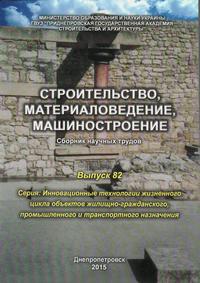Peculiarities of low-rise residential floating houses design according to the shipbuilding codes
Keywords:
low-rise residential floating houses, technical-exploitational parameters, buoyancy, stability, design codesAbstract
Summary. Raising of problem. Erection of floating buildings and structures is one of the newest direction in construction and architecture, which becomes popular in Ukraine resently. Normative base for design, constuction and exploitation of residential floating houses is practically absent and present investigations related to floating houses design mainly have reviewing style. The characteristic feature of floating house is a combination of functional peculiarities of a traditional house and a ship. Therefore while designing of low-rise residential floating house, among guaranteeing strength, stability, durability, etc., the main objective is to ensure safe exploitation according to the shipbuilding. Purpose. Development of method of determination and verification of main technical-exploitational parameters (seat, buoyancy, stability, floodability) of low-rise residential floating houses according to the operating shipbuilding codes. Conclusion. According to the analysis of the normative and technical documents existing in building and shipbuilding industries, criteria of safe exploitation of low-rise residential floating houses were defined. The method of determination of technical-exploitational parameters of low-rise residential floating houses was developed considering demands of the Shipping Register of Ukraine. According to the analysis of approaches to the determination of wind loads according to the standards of the Shipping Register of Ukraine and DBN В.1.2-2:2006 “Loads and effects” it is determined that use of wind load values from building code is more reasonable in stability calculations.References
Bekenskiy B. V. Prakticheskie raschety morekhodnykh kachestv sudna [Practical calculations of seagoing qualities of ship]. Moscow, Transport, 1974. 264 p.
Blagoveschenskiy S. N. Spravochnik po statike i dinamike korablya [Statics and dynamics of ship handbook]. Leningrad, Sudostroyeniye, 1976.
Бунгало по-украински [Электронный ресурс]. –Режим доступа : http://www.seychas.ua/money/2007/8/22/articles/49338.htm. –Загл. с экрана. Bungalo po-ukrainski [Bungalows in Ukrainian]. Available at: http://www.seychas.ua/money/2007/8/22/articles/49338.htm.
Дом на воде [Электронный ресурс]. – Режим доступа : http://www.domnavode.ru/. – Загл. с экрана. Dom na vode [A house on the water]. Available at: http://www.domnavode.ru/.
Mishutin N.V. Mishutin A. V. Zhelezobetonnyye plavuchie soorujeniya I perspectivy ih ispolzovaniya [Reinforced concrete floating structures an perspectives of their application] Visnyk Odeskoi derjavnoi akademii budivnyctva ta arkhitectury [Bulletin of Odeska State Academy of Civil Engineering and Architecture], 2002, issue 6, pp. 181 – 186.
Nagruzki i vozdeystviya. Normy proektirovaniya [State Building Code V.1.2-2:2006 Loads and impacts. Norms of design]. Kyiv, Minstroy Ukrainy, 2006. 9 p.
Pravila postroyki i klassificatsyi malykh sudov [Rules of construction and classification of small ships]. Kyiv, Registr sudohodstva Ukrainy, 2007.
Pravila postroyki i klassificatsyi sudov vnutrennego plavaniya [Rules of construction and classification of small ships]. Kyiv, Registr sudohodstva Ukrainy, 2006.
Borisov R.V. Statica korablya: uch. Posobiye [Ship statics:tutorial]. St. Petersburg, Sudostroyenie, 2005. 256 p.
Stroitelstvo domov na vode [Construction of floating buildings] Available at: www.floating-house.com.ua.
Design Studies on Flood-Proof House / D. Han [a. oth.]. – Bristol, 2007. – 37 р. http://www.architecture.com/files/ribaprofessionalservices/competitionsoffice/resultsbooklets/norwichunionfloodproofhou seofthefuture.pdf
Koekoek M. Connecting Modular Floating Structures: A General Survey and Structural Design of a Modular Floating Pavilion: Master Thesis / M. Koekoek. – Delft University of Technology: Netherlands, 2010. – 173 p. http://repository.tudelft.nl/view/ir/uuid:33b59201-1718-4dda-98f8-ee16d5b7c023.
Patrick Y. Development of integrated floating house conceptual model for flood prone area in Malaysia : NOAH project, Universiti Teknologi Malaysia, Malaysia, 2012. http HYPERLINK "http://eprints.utm.my/9432/":// HYPERLINK "http://eprints.utm.my/9432/"eprints HYPERLINK "http://eprints.utm.my/9432/". HYPERLINK "http://eprints.utm.my/9432/"utm HYPERLINK "http://eprints.utm.my/9432/". HYPERLINK "http://eprints.utm.my/9432/"my HYPERLINK "http://eprints.utm.my/9432/"/9432/
Downloads
Published
Issue
Section
License
Редакція Видання категорично засуджує прояви плагіату в статтях та вживає всіх можливих заходів для його недопущення. Плагіат розглядається як форма порушення авторських прав і наукової етики.
При виявлені у статті більш ніж 25% запозиченого тексту без відповідних посилань та використання лапок, стаття кваліфікується як така, що містить плагіат. У цьому випадку стаття більше не розглядається редакцією, а автор отримує перше попередження.
Автори, в статтях яких повторно виявлено плагіат, не зможуть публікуватися в усіх журналах Видавництва ДВНЗ «Придніпровська державна академія будівництва та архітектури».
Автори, які публікуються у цьому журналі, погоджуються з наступними умовами:
- Автори залишають за собою право на авторство своєї роботи та передають журналу право першої публікації цієї роботи на умовах ліцензії Creative Commons Attribution License, котра дозволяє іншим особам вільно розповсюджувати опубліковану роботу з обов'язковим посиланням на авторів оригінальної роботи та першу публікацію роботи у цьому журналі.
- Автори мають право укладати самостійні додаткові угоди щодо неексклюзивного розповсюдження роботи у тому вигляді, в якому вона була опублікована цим журналом (наприклад, розміщувати роботу в електронному сховищі установи або публікувати у складі монографії), за умови збереження посилання на першу публікацію роботи у цьому журналі.
- Політика журналу дозволяє і заохочує розміщення авторами в мережі Інтернет (наприклад, у сховищах установ або на особистих веб-сайтах) рукопису роботи, як до подання цього рукопису до редакції, так і під час його редакційного опрацювання, оскільки це сприяє виникненню продуктивної наукової дискусії та позитивно позначається на оперативності та динаміці цитування опублікованої роботи (див. The Effect of Open Access).

